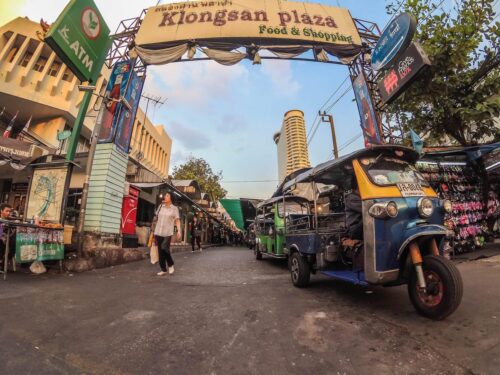Bangkok attraction (Thonburi Bank) : the King of Thon Buri Statue, Princess Mother Memorial Park, Khlong San Pier, Thekka Moral Association Chee Chin Khor, Guan Yu Shrine, Patjamit Fort, Thong Noppakhun Temple, Thong Thammachat Temple, Wat Anong Karam, Sefi Mosque and Kuwatil Islam Mosque.
Table of Contents
Khlong San Pier
![]() Photo credit: Icon Siam facebook
Photo credit: Icon Siam facebook

It is the pier to cross the Chao Phraya River which is linked to Si Phraya Pier. Even though they are just on the opposite side of the river, Khlong San Pier has a different charm from Si Phraya Pier because it is the centre of cheaper products: “Khlong San Plaza”.
There are clothes, utensils, including food and desserts. There is one famous ‘Bua Loy’ shop which always has people queuing up. Although it is not very different from Trok Wang Lang or other similar pier markets, Khlong San Plaza opens until night time, so people can enjoy themselves after work.

Lately Khlong San Pier has been famous for another aspect after the launching of “The Jam Factory”, a ‘factory’ of creativity from the adaptation of a deserted storehouse by the river not far from the pier. It has become a small community for modern people. It answers your needs by gathering restaurants, galleries, bookshops, cafes; all in the same place, If you turn into the small alley in the middle of this busy market, you will meet a compact and modern green space which is different from its surroundings designed by Duangrit Bunnag, architect and founder. Location: Charoen Nakhon Rd., the entrance is opposite to Soi Charoen Rat.
The King of Thon Buri Statue
 The King of Thon Buri Statue at Wongwian Yai. Photo credit: wikipedia.org
The King of Thon Buri Statue at Wongwian Yai. Photo credit: wikipedia.org
The King of Thon Buri Statue was made in the period of Plaek Phibunsongkhram, and located in the middle of Wongwian Yai, which is the centre of Thon Buri, or Thon Buri Bank. Thon Buri was established by King Thon Buri, generally known as ‘King Taksin the Great’.
The King of Thon Buri Statue was designed by Professor Silpa Bhirasri, who also controlled the molding process. The artist who made the King of Thon Buri Statue is Sawang Songmangmee. The official launching was on 28 December 1954. The government later made 28 December, his coronation day, as a day to pay homage to the King Thon Buri statue or ‘King Thon Buri Monument Day’.
The King of Thon Buri Statue is dressed in his armor on an active war horse and raising his right arm, a sword in his hand, ready to give his order to the army. This creative art greatly portrays his courage and majesty. Location: Wongwian Yai.
Thekka Moral Association Chee Chin Khor

 Photo credit: bangkokriver .com
Photo credit: bangkokriver .com
Itpswww.t was founded in 1952 and is a centre of Mahayana Buddhist doctrine, includ that of Tao and Kong Jue. The associa- tion publishes dharma principles and makes merit. Her Royal Highness Princess Maha Chakri Sirindhorn came to be the principal to open the display of the god temple in 1993.
The remarkable part of this place is the big pagoda of ‘Phra Jomchatri Thai Jeen Chalerm’ which was built for the fifth anniversary of the foundation for making merit for the ninth reign and the 72 years of birth celebration, Somdet Phra Yannasangworn Somdet Phra Sangaratch Sakon Maha Sanga Parinayok came to be the principals in the association ceremony. The big pagoda was built as a Chinese tower, with eight floors. It is remarkable when you see it from the other side of the river. Location: Somdet Chao Phraya Rd. Soi 17
Guan Yu Shrine


It is an old shrine more than 268 years old. There are three Guan Yu statues in Keng (house with a Chinese style roof). One is the small Guan Yu statue which was placed as the first statue in Thailand in 1736, Emperor Chenglong’s period, Qin dynasty. The second one was placed in 1802 in the same period of Emperor Jiaching, Qin dynasty. The last one was placed in 1822 in the same period of Emperor Taokuang, Qin dynasty.
 Photo credit: eviewpromote.com
Photo credit: eviewpromote.com
The magnate ‘Kungseng’ was the one who renovated Keng and placed the third Guan Yu statue with others. He also built a bell. After that the committee and disciples built a new Keng because the former Keng was old, The Guan Yu Shrine is the soul of Thai-Chinese people from the past to present. Location: Soi Utai, Somdet Chao Phraya Rd.
Patjamit Fort

 Photo credit: manager.co.th
Photo credit: manager.co.th
It is the only fort located in Thon Buri. It was built in the fourth reign at the same time of Khlong Phadung Krung Kasem dredging to expand Bangkok. The name of the fort means protecting the enemy, but the fort was used for building good relationships with other countries by gun-salute to welcome foreign ambassadors.
In the fifth reign, it is used for signal flags to inform when cargo goes in and out of Bangkok. In the sixth reign, a metal flag staff which was in the palace at Phadej Dassakorn was moved to be placed at the fort. At present the fort is located in the office of the Khlong San District. The marine Department wanted to pull down the fort, but the Fine Arts Department wanted to keep it as evidence of history. Location: Lat Ya Rd. Soi 21
Thong Noppakhun Temple (Wat Thong Noppakhun)

The old temple was built in the Ayutthaya period, and was renovated greatly in King Rama IV’s period. The temple is remarkable for many aspects; the hall and windows, which were built in monk fan shape; the mural drawn by Phra Khru Kasin Sangworn (Mee), the disciple of Khrua In Khong; the painting of Phra Visutra (Marn) behind the Buddha image, which caused King Rama IV to ask, “Who hung the curtain (Marn) behind the Buddha?”; the Dharma puzzle painting, depicting three trees that is a metaphor for the Three unwholesome roots (attachment, ignorance, aversion).
The painting is the integration of Buddhist ideas and master artistic skille, including Thai, Chinese and Western styles into one work. Although Phra Kasin Sangworn’s works had wemwpressed King Rama IV, the nudity in so the; bc#ridated the King and had to be revisited. Arcuard the temple is beautiful and calm, and there is also a bike lane as far enough to visit Khlong San. Location: Somdet Chao Phraya Rd. Soi 17
Wat Thong Thammachat

 Photo credit: manager.com
Photo credit: manager.com
King Rama I saw the restoration of this old temple, built in the Ayutthaya period, because the bad state it was in. The Buddha image of the temple is in the defeating evil gesture, which King Rama IX gave the name, ‘Phra Phuttha Shinna Chat Thammakhun’. The mural, drawn in 1832, is very beautiful. Behind the Buddha is the painting of Tribhumi, opposite is the legend of Buddha, and on the side is the community and Bangkokian way of life in the past. Location: Chiang Mai Rd.
 Photo credit: traipidok .org
Photo credit: traipidok .org
Wat Anong Karam Woravihara
 Photo credit: dhammathai .org
Photo credit: dhammathai .org
Wat Anong Karam is originally named ‘Wat Noi Kham Tam’ after its founder Thanpuying Noi who was the wife of Chao Phraya Borommahapichai, Tid Bunnag. Wat Anong Karam was built in the Thai style, with bricks covered with cement, glazed tile, gable apex and bairaka covered with lacquer and decorated with glass. The edges of the roof, the doors and windows of Wat Anong Karam were covered with lacquer and gold leaves.
 Wat Anong Karam. Photo credit: dhammathai .org
Wat Anong Karam. Photo credit: dhammathai .org
Wat Anong Karam has been housing Phra Buddha Jullanak, an important statue of Buddha in the Sukhothai Pang Mara Wichai period. There is also a library and a local museum in the Khlong San District. Location: Soi Utai, Somdet Chao Phraya Rd.
Sefi Mosque (Tuek Khao) and Kuwatil Islam Mosque (Tuek Daeng)

 Photo credit: dulyapaween . com
Photo credit: dulyapaween . com
“Sefi Mosque”, an old mosque of Thon Buri, was built in 1910 by Indian merchants in King Rama IV’s period. It is a centre of Dawoodi Bohra, or known as ‘Khak Tuek Khao’, Shi’a Muslims who migrated from India. The faithful dress in white with gold-rimmed hat. The name ‘Tuek Khao'(white building) came from the colour of the buildings in the area. The mosque is a half concrete and half wooden structure built in the Gothic style which is painted in a light yellow colour. It is unique in the style of Dawwodi Borah that it was built without an altar or a tower. Sefi Mosque : Location : Soi Chang Nak, Somdet Chao Phraya Rd.

 Photo credit: bangkokriver .com/th
Photo credit: bangkokriver .com/th
Sunni Muslims built “Kuwatil Islam Mosque” in 1859. Some of them were from Pattani and expertise in goldsmithing and some were from India with expertise in merchandise. The well-known names are Nana, Wongsaraya and Amantakul who once lived in a community near Sapan Phut, Later, Lek Nana gave his land for the construction of the Royal Park in honor of the Princess Mother, because she once lived in the area. The mosque was built by Indian artisans in the architec tural style based on mosques of the Mughal Empire in India. This area was originally a Chinese neighborhood. The shop houses built here were painted red and so the mosque was also called ‘Tuek Daeng’ which means red building. Kuwatil islam Mosque : Somdet Chao Phraya Rd. Soi 1, at the bank of the Chao Phraya River.
Princess Mother Memorial Park
 Statue of Princess Mother at Princess Mother Memorial Park
Statue of Princess Mother at Princess Mother Memorial Park
Princess Mother Memorial Park is the preservation of old buildings in the former residence of Princess Sri nagarindra, or ‘Princess Mother’. It aims to be a museum that is dedicated to her, according to H.M. King Rama IX. Princess Mother Memorial Park thus provides the feeling of coming home. In the little garden, there is one miniature of her childhood home, decorated according to the description in the book ‘Mom’s story’, written by Princess Galyani Vadhana.


At Princess Mother Memorial Park, there is one house from the early Rattanakosin period of ‘Chao Phraya Phipat Rattanaratch kosathibadi’ (Pae Bunnag), the former owner, which is still well-reserved and used for art exhibition.

 Photo credit: theprincessmothermemorialpark .org
Photo credit: theprincessmothermemorialpark .org
In the front museum building there is a complete collection about the Princess Mother’s biography. You will learn a lot of things here. Location: Somdet Chao Phraya Rd. Soi 3
To explore the Princess Mother Memorial Park, check out Explorenique’s “Original Bangkok Riverside Walk” This walking experience takes you offbeat exploring the side of Bangkok that is less known by tourists and even locals.
Somdet Chao Phraya Hospital Museum

It belongs to Somdet Chao Phraya Institute of Psychiatry, Thailand’s first psychiatric hospital. It is located in the middle of a green garden, in a big European building with a tower. It is also known as ‘the Red Roof House’. It received the Best Reservation Award from The Association of Siamese Architects in 1987.
 Photo credit: โรงพยาบาลบ้านสมเด็จเจ้าพระยา เฟสบุ๊ค
Photo credit: โรงพยาบาลบ้านสมเด็จเจ้าพระยา เฟสบุ๊ค
It shows the hospital’s history and exhibits strange ancient tools for treating psychiatric patients such as electronic shock, cold operation tools, etc., which show the development of psychiatric treatment. There is also a room showing duplicate models of patients: crazy patients tied to the bed, and the ancient treatment. Location: in the Somdet Chao Phraya Institue of Psychiatry, Somdet Chao Phraya Hospital.
Looking for best area in Bangkok to stay for your vacation, click here to get some ideas about where to stay.
Follow us on Facebook, Instagram, Twitter, Youtube, and Pinterest to explore more local Bangkok experiences.


